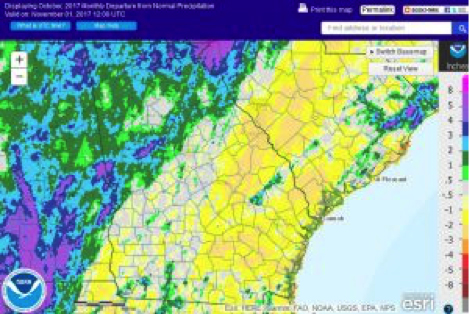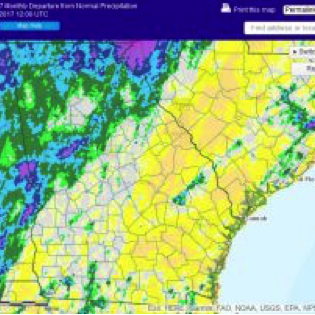If this October’s temperatures didn’t have you craving pumpkin spice, you’re not alone. The entire state was about four degrees warmer than normal this year.
While the dry, warm weather may have made it hard to celebrate the beginning of fall, it was great for Georgia agriculture, aiding in the harvest of cotton, peanuts and soybeans across the state.
However, the lack of moisture late in the month, particularly in southeastern Georgia, did hinder the maturity of late-planted cotton and peanuts and made it difficult to dig peanuts ready for harvest. It also caused delays in planting of winter grains and forages across the state.
Precipitation across Georgia in October varied quite a bit.
During the first half of the month, areas affected by Hurricane Nate in the northwestern part of the state were generally wetter than normal. Other areas were fairly dry, missed by Nate and thunderstorms from a strong front later in the month in the coastal plains.
Parts of the state that did not receive significant rain from Hurricane Nate or frontal showers were designated as abnormally dry by the U.S. Department of Agriculture Drought Monitor by the end of the month, although no drought conditions were identified.
The highest monthly total precipitation from National Weather Service reporting stations was 5.71 inches in Athens, Georgia, 2.16 inches above normal, and the lowest was Augusta, Georgia, with 0.83 inches, 2.44 inches below normal.
- Atlanta received 3.87 inches, 0.46 inches above normal.
- Columbus, Georgia, received 4.62 inches, 2.04 above normal.
- Macon, Georgia, received 2.94 inches, 0.15 above normal.
- Rome, Georgia, received 4.90 inches, 1.04 above normal.
- Savannah, Georgia, received 1.65 inches, 2.04 below normal.
- Albany, Georgia, received 2.01 inches, 0.58 below normal.
- Brunswick, Georgia, received 2.01 inches, 2.45 below normal.
- Valdosta, Georgia, received 3.79, 0.59 above normal.
- Alma, Georgia, received 1.66 inches, 1.37 inches below normal.
One daily rainfall record was set in October. Columbus received 2.10 inches on Oct. 23, surpassing the old record of 2.03 inches set in 1945.
The highest daily rainfall total from Community Collaborative Rain, Hail and Snow network volunteers was 7.22 inches, recorded in Dillard of Rabun County, Georgia, on Oct. 9, followed by 4.76 inches measured near Rayle in Oglethorpe County, Georgia, on Oct. 24. The Dillard amount was during the passage of Hurricane Nate, and the Rayle rainfall was during a strong cold front.
For the entire month, the highest total was 16.31 inches, measured by the observer in Dillard, followed by 10.21 and 9.72 inches from two Rabun Gap, Georgia, observers, and 9.46 inches measured by another observer near Dillard. All of these observations were in Rabun County in the northeast mountains. Community Collaborative Rain, Hail and Snow Network (CoCoRaHS) volunteers in northern Georgia also noted some ice pellets and snow flurries on Oct. 29 and 30, although no accumulations were measured.
High-temperature records were set at numerous stations on Oct. 10, 11 and 12, and high-nighttime-temperature records were set across the state on Oct. 8 and 9, with nighttime temperatures generally in the low to mid 70's.
In Atlanta, those records had remained unbroken since 1884 and in Augusta since 1882, and Augusta's records were broken five mornings in a row. High-nighttime-temperature records were also broken on October 10 in Savannah, Alma and Brunswick and on Oct. 13 and 14 in Brunswick.
- In Atlanta, the monthly average temperature was 65.7 degrees Fahrenheit, 2.4 degrees above normal.
- In Athens, the monthly average was 64.3 F, 1.3 degrees above normal.
- In Columbus, Georgia, the monthly average was 69.5 F, 3.0 degrees above normal.
- In Macon, the monthly average was 67.4 F, 2.5 degrees above normal.
- In Savannah, the monthly average was 71.2 F, 3.3 degrees above normal.
- In Brunswick, the monthly average was 73.5 F, 3.3 degrees above normal.
- In Alma, the monthly average was 71.3 F, 2.9 degrees above normal.
- In Augusta, the monthly average was 68.5 F, 4.1 degrees above normal.
- In Albany, the monthly average 71.4 F, 3.3 degrees above normal.
- In Rome, the monthly average was 63.2 F, 2.1 degrees above normal.
- In Valdosta, the monthly average was 70.4 F, 1.7 degrees above normal.
In spite of the passage of the remains of Hurricane Nate during the month, only three official reports of damage from high winds were made during the entire month, one on each of three separate dates, although some additional reports were noted in local newspapers.
For more information, please visit our blog at blog.extension.uga.edu/climate/. We are also on Facebook at SEAgClimate and on Twitter at @SE_AgClimate. Please feel free to email your weather and climate impacts on agriculture to pknox@uga.edu.








